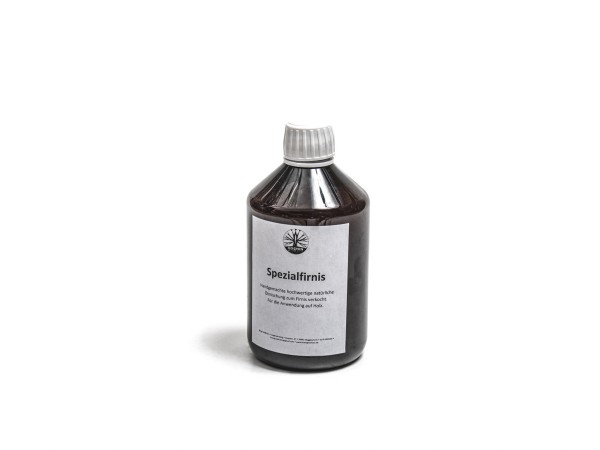
Prices incl. VAT plus shipping costs
Ready to ship today,
Delivery time appr. 1-3 workdays
SORRY BUT UK MAINLAND DELIVERY ONLY.
Linseed and Tung Oil Varnish is used to treat wood for a deep matt, resistant, UV-stable, very robust and water-repellent surface. The linseed and tung oil varnish is made from high-quality raw materials and has been specially prepared for the surface treatment of wood in a complex process. The varnish is suitable for use on the lathe and in all areas of woodworking.
This linseed and tung oil varnish is ideal if you want to achieve a resistant, oil-based surface. Whether for bowls or plates, writing utensils, cupboards and chests of drawers or for benches or wooden houses whose surfaces need to be weather resistant.
The wood remains wood! With the linseed and tung oil varnish, the wood retains its originality, as it is not sealed as with a varnish layer, but absorbed into the wood fibres. The wood can thus continue to work and breathe. As it remains open-pored and permeable to moisture without swelling when it comes into contact with water.
Ingredients Special varnish
Tung oil, linseed oil
What is the advantage of linseed and tung oil varnish?
- Breathable: The treated wood remains breathable and retains its warm, natural character.
- Durability of the surface: Due to the relatively slow hardening of the oil, it can penetrate deeply and thus harden the surface.
- The surface does not become brittle or cracked due to changes in shape. The oil varnish works with the wood.
- Repair-friendly: Minor damage or wear can be easily removed by repolishing with the same oil.
- Enhancing the grain: oiling emphasises the grain of the wood and brings out its natural beauty.
- Deep natural shine
- Strong protection in all areas
Why linseed oil and tung oil varnish?
For the treatment of wooden surfaces, vegetable oils are proven means without losing the natural appearance of the wood. The Linseed Oil and Tung Oil varnish from König Holz und Harz has the great advantage that it has been treated in such a way that it hardens more quickly without significantly affecting the beneficial wood protection properties of vegetable oils.
But to understand why King Wood and Resin's linseed and tung oil varnish is so special, we should take a look at why vegetable oils, such as linseed oil and tung oil, are so good for woodworking in the first place. Both oils oxidise due to the oxygen in the air and harden. During hardening, the liquid oil changes into a solid, elastic and rubber-like state due to the linking of the oleic acids. As a result, a clear, water-repellent protective layer also forms on the surface of the wood, making treated workpieces particularly impressive in terms of durability, weather resistance and suitability for everyday use.
The linseed and tung oil varnish is processed to shorten the curing process. By heating the oil mixture gently and for a long time, pre-oxidation takes place, which triggers the linking (polymerisation) of the fatty acids (molecules) of the oils. This process gives the product its viscous structure. While conventional varnish has a curing time of 6 to 8 weeks, the König Holz und Harz varnish cures after only 1 to 2 weeks, thanks to the elaborate processing.
The most important properties at a glance
- UV - stable
- Scratch resistant
- Weather resistant
- No additives!
- Very durable
- Made from natural, renewable raw materials
- Made in Germany
- High quality ingredients
- Very high content of tung oil
- Very glossy
- Vegan
Examples of use for König Holz und Harz Linseed and Tung Oil Varnish
- Bowls, plates, chopping boards
- Tables, worktops
- Wooden facades
- Wooden houses
- Park benches and tables
Application of linseed and tung oil varnish
Condition of the wood
- The wood should be dry for processing, i.e. have a moisture content of 10 - 15%.
- Hardwoods and softwoods are equally possible
- The surface should be sanded to a maximum of 400 grit, depending on the desired gloss level.
- Sanding dust should be removed before application.
Applying the varnish on the woodturning machine
The wood should be completely untreated and sanded to a maximum of 400 grit so that the pores can absorb enough varnish and it can penetrate deeply.
Apply the varnish in thin layers with a cloth. You can remove the excess after 5-10 minutes. After 24 hours, the varnish can be polished up. The process can be repeated one more time.
Linseed and Tung Oil Varnish by hand on tables, worktops or outdoors
For larger surfaces, mix the varnish 1:1 with turpentine balsam. The surface should have been prepared as described above. The varnish can be applied by brushing, rolling or spraying. After 5 minutes, the excess can be removed.
Depending on the surface result, the process can be repeated a second time. If the fibres of the wood have set up, they can be sanded again with the last grit used. Afterwards, another layer of varnish can be applied.





































